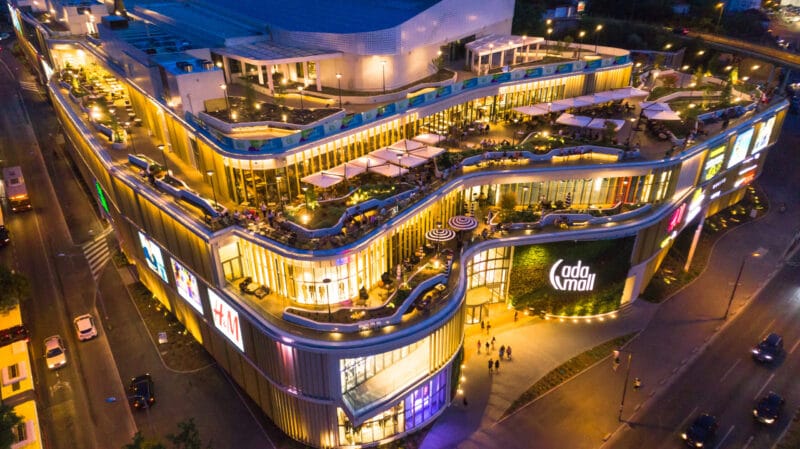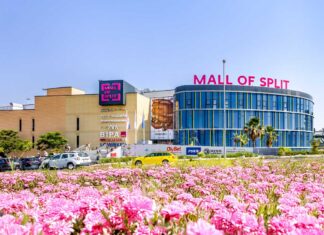Alex Linchev, Shopping Center General Manager of Ada Mall, gives us great insights into how the pandemic has pushed the retail industry to improve from manufacturing to the overall shopping experience.
A lot is being speculated about the retail industry and its current shape as a result of the pandemic. What major changes have you noticed that have taken place and do you see it as a negative or positive transformation?
The retail market has not been in such an upheaval and overhaul since the Industrial Revolution. Many retailers faded away and some retail categories suffered from supply shortages, but these subdued problems were existing vulnerabilities prior to the pandemic that just came into light during the crisis.
2021 was truly revolutionary for retail. Retailers shifted away from the 150-year-old oligopolistic shopping model where manufacturing and store supplies were planned out based on the presumption that they were catering to “greedy” consumers that need to shop more and more each year.

Now we have leaped into a customer-centric world, where understanding properly the new-age consumer and demands drives supply. Creating an experience, rather than just focusing on transactions, is now at the heart of every retail business. Off and online retail is not seen anymore as competing models, but rather as inseparable parts of the new shopping experience.
This year, for the first time since 2017, the retail industry is planning to open more brick and mortar shops worldwide than it closed down. This is because the pandemic actually provided some silver linings that helped retailers bounce back better than most expected.
Here are some of the ways the pandemic actually transformed the retail market for the better:
Smarter Store Expansion
First of all, there were far too many stores and overexpansions prior to the pandemic that started in the ‘80s in Western Europe and towards the end of the ’90s in Central Eastern Europe. This is because large retail corporations believed they needed as many stores as possible and in formats as large as possible to keep their market shares.
The pandemic helped correct this, sifted out unprofitable stores, and established a new expansion paradigm centered around convenience, omnichannelism, experience, and interaction with the brand.
Better Inventory and Better Margins
The old oligopolistic shopping model relied on limitless positive sentiment from the retailers, where the production really ‘guessed’ far too generously the demand, and as a result, stores were constantly dealing with excess inventory.

Retailers were always thinking they were going to sell more than they actually did. This propelled a downward spiral, where in order to sell anything, stores had to discount products far more often than their healthy margins could accommodate. Coupled with the pressure from online retail, where it all came down to price comparison, a stationary retail bubble was created.
When the pandemic hit us, supply was disrupted and demand diminished, but so did excess inventory in the stores. Managers became more in tune with their customers’ rapidly changing habits. This resulted in creating a well-balanced stock, which no longer required stores to provide ceaseless discounts on ordered but not needed items or quantities.
Because of this, the inventory turnout is now much better for many fashion stores, and although their turnovers are still not as high as the pre-pandemic boom years, their margins are very often better. Of course, this observation comes with a caveat that the new trend will remain positive provided that supply and commodity prices will normalize and inflation will be transitory.
Faster Delivery, Lower Costs & Better Service
Due to the pandemic retailers realized that the traditional physical stores can have many other uses and can complement, not cannibalize their online businesses.
Store sizes were optimized and layout tuned to include in-store pick-ups and returns services. This way delivery costs and time were reduced by using the stores as last-mile fulfillment centers that are closer to the customers’ homes compared to the warehouses.

Most importantly, all shops started to create a better bond with their visitors and to offer better services. For example, Levi Strauss added in-store tailor services to customize jeans and IKEA launched Planning Studios, where design specialists can help customers plan and order furniture solutions.
Online and Offline Retail Working Together
In a world where 85% of all retail is still offline and where consumers have displayed their innate preferences for experience and fun shopping, shops, and online channels have now no other option than to work together.

Even the online giants have jumped into physical store expansions. For instance, Amazon bought Whole Foods and opened its own Amazon cashless grocery shops. They also recently opened Amazon 4 Star shop in Westfield shopping center in London where they sell trending goods from their website, covering categories such as books, games, and toys, giving customers the option to buy online and pick up in-store the next day, or drop a return.
Physical retailers are better suited in this omnichannel effort, since setting up an online business is easier for an experienced stationary retailer. Many physical retailers already had an online presence and just needed to enhance it during the pandemic. However, both online and offline retailers have at their hands the weapon of consumer data. Using trillions of gigabytes of data through loyalty applications, retailers know more than ever about their consumer needs and pains. And this is what is going to drive future retail and supply – a customer-centric model.
As a testament to that, just notice how accurate those social media ads have become in our Facebook newsfeed!
So with the new norm of the customer-centric approach and physical retail reinventing itself to become part of the omnichannel experience, have you seen a good example of shopping centers turning into, as you once put it in one of our previous interviews, ‘consumer engagement hubs’. Do you aspire to turn Ada Mall into such a community engagement center?
Talking about shopping centers as engagement centers, I feel a lot is missed out, and very often a lot is underestimated. Almost every shopping center nowadays claims to have achieved that and almost every mall manager will tell you that this is the future for their asset. An engagement-center mall however is a very high-stake high-entry model which requires enormous customer data analysis and synergies with the city community.
One example of a truly customer-centric shopping center of the future is Ingka Group (the mother company of IKEA) which launched its latest “meeting place” mall destination called “Livat Changshka” in China. It includes nearly 400 shops, 500 live-work units, 12.000 m2 of green areas, a vibrant mix of cafes and restaurants, sports and cultural facilities, digital touchpoints, a “Livat Family” loyalty program, communal services, and much more.

Ada Mall currently has the privilege of having an exceptionally strong loyalty program where we see consumer behavior intelligence data in real-time from some 30.000 members of our core target audience. This is a priceless opportunity to understand better our customers and to provide a better service. Once we get an upper hand on this, Ada Mall will move closer to a true consumer-engagement retail center.
Based on the new shifts in consumer behavior, so far we have managed to secure common area pick-up points, a designer fashion hub, an in-mall free Library and Study Center, a new digital playground, an escape room, and a “scary” maze suitable for groups and company team buildings. We also have our application-based loyalty program, application-based online shop for loyalty prizes, in-mall receipt registration, and loyalty prize collection points, in-mall lockers and bike stands, direct footbridge to Ada Ciganljia park (which is fully built but expected to receive its Usage permit in spring 2022) and of course above all an awe-inspiring interior and exterior which make each visit a truly aesthetic experience.
All these, together with the uptick in new residential and retail developments in our immediate catchment zone, move us closer to a genuine community engagement center.
About Alex Linchev
Alex Linchev is a Retail Asset Director for GTC S. A. currently in charge of Ada Mall Belgrade. He has been present in the real estate industry for over 15 years leading residential, commercial, and retail assets as well as signature world golf clubs.
Throughout his career, he has strategically collaborated with over 300 international tenants, managed more than 150 000 m2 of the shopping center and office space, and worked for one of the biggest international developers in the CEE region.
Mr. Linchev’s asset management experience includes United Kingdom, Bulgaria, and since September 2019 Serbia. He is ICSC certified and is one of the longest-serving GTC S.A. retail asset directors. His side interests include digital marketing, psychology, and consumer analytics.









